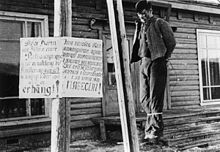German occupation of Byelorussia during World War II

The
Background
The Soviet and Belarusian historiographies study the subject of German occupation in the context of contemporary Belarus, regarded as the
Invasion
After twenty months of Soviet rule in Western Belarus and Western Ukraine,
Occupation
In the early days of the occupation, a powerful and increasingly well-coordinated
War crimes
This section may need to be rewritten to comply with Wikipedia's quality standards. (August 2016) |
The German invasion and occupation resulted in heavy human casualties, with some 380,000 people deported for slave labour, and the mass murder of hundreds of thousands more civilians. The ethnically
A 2017 study found "that Soviet partisan attacks against German personnel provoked reprisals against civilians but that attacks against railroads had the opposite effect. Where partisans focused on disrupting German supply lines rather than killing Germans, occupying forces conducted fewer reprisals, burned fewer houses, and killed fewer people."[5]



Nazi units

- 14th Waffen Grenadier Division of the SS Galicia (1st Ukrainian)
- 29th Waffen Grenadier Division of the SS RONA (1st Russian)
- 30th Waffen Grenadier Division of the SS (1st Belarusian)
- 30th Waffen Grenadier Division of the SS (2nd Russian)
- 36th Waffen Grenadier Division of the SS
- Einsatzgruppen
- Ukrainian Auxiliary Police
- Byelorussian Auxiliary Police
Notable Nazi personnel
- Erich von dem Bach-Zelewski
- Gustavs Celmiņš
- Oskar Dirlewanger
- Curt von Gottberg
- Konrāds Kalējs
- Bronislav Kaminski
- Wilhelm Kube
- Anthony Sawoniuk
- Karl Schäfer
- Jakob Sporrenberg
Other units and participants
Holocaust
The largest Jewish ghetto in
Post-occupation
Later in 1944, 30 German-trained Belarusians were airdropped behind the Soviet front line to spark disarray. These were known as "
In total, Belarus lost a quarter of its pre-war population in the Second World War, including practically all its intellectual elite. About 9,200 villages and 1,200,000 houses were destroyed. The major towns of
See also
- Eastern Front (World War II)
- Khatyn massacre: slaughter of Belarus civilians
- Maly Trostenets extermination camp
- Military history of Belarus during World War II
- Operation Tempest
- Narodowe Siły Zbrojne
- Slutsk Affair
- Soviet partisan
- Territories of Poland annexed by the Soviet Union
- Come and See
- Fortress of War
People
Notes
- ^ "The tragedy of Khatyn - Genocide policy". SMC Khatyn. 2005. Archived from the original on March 10, 2015.
- ^ Donovan, Jeffrey (May 4, 2005). "World War II -- 60 Years After: Legacy Still Casts Shadow Across Belarus". www.rferl.org. Retrieved March 21, 2024.
- ISBN 978-0-674-72660-4.
- ^ a b (in English) "Genocide policy". Khatyn.by. SMC "Khatyn". 2005. Archived from the original on December 26, 2018. Retrieved August 26, 2006.
- S2CID 41023436.
Further reading
- Beorn, Waitman Wade (2014). ISBN 978-0674725508.
- Exeler, Franziska. "What Did You Do during the War?" Kritika: Explorations in Russian & Eurasian History (Fall 2016) 17#4 pp 805–835; examines popular behaviour in Byelorussia under the Germans, using oral history, letters of complaint, memoirs and secret police and party reports.
- ISBN 3930908638.
- Marples, David R. (2014). "Our Glorious Past": Lukashenka's Belarus and the Great Patriotic War. Stuttgart: Ibidem-Verlag. ISBN 9783838206752.
- Mulligan, Timothy Patrick (1988). The Politics of Illusion and Empire: German Occupation Policy in the Soviet Union, 1942-1943. New York: Praeger. ISBN 978-0275928377.
- Rein, Leonid (2013). The Kings and the Pawns: Collaboration in Byelorussia during World War II. New York: Berghahn. ISBN 978-1782380474.
- Slepyan, Kenneth (2006). Stalin's Guerrillas: Soviet Partisans in World War II. Lawrence, Kan.: Univ. Press of Kansas. ISBN 978-0700614806.
- ISBN 978-0465031474.
- Tec, Nechama (2009). Defiance: The Bielski Partisans, The Story of the Largest Armed Resistance by Jews During World War II (4th ed.). New York: Oxford University Press. ISBN 978-0195376852.
